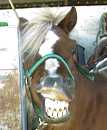
How to tell a Horse's Age by his Teeth
Jim Hamilton, DVM
Starting at 2 years of age the horse's front teeth (incisors)
are the way to tell age. There are three sets of incisors,
central, intermediate and corners. Open the horse's lips
and look to see if all are baby teeth or adults.
The central pair are adult (permanent at 2 - 2 1/2 years.,
the intermediate at 3 - 3 1/2 years and the adult
corner incisors at 4 - 4 1/2 years. At 4 1/2 - 5 1/2
years of age some horses (mostly males) grow
canine teeth which is that fang-like tooth just behind the
incisors.
Now starting at six years old, you need to look at the
flat (table) surface of the lower incisors. There is a pit
called the infundibulum that is easily seen in the center
of each incisor's flat surface. At six years of age the
pits of lower central permanent incisors are worn out
(disappear).
At 7 years the lower central incisors lose their pit and the
upper corner incisor develops a hook off the back edge.
By 8 years, all the lower adult incisors have lost their pit
but a new small depression (dental star) appears in the
lower central incisors.
At 9 years of Age, the horse's lower central and intermediate
and intermediate and upper central incisors will have a
dental star but the infundibulum (pit) of the upper corner
incisor is still present - they do not disappear until the
horse is eleven years old.
From the age of eleven on, the incisors become more
triangular and the teeth begin to project out toward the
front of the mouth more with each additional year.
The best way to get good at aging horses is by practice.
Look at as many horses of know age and test yourself.
Some day you'll save a friend from buying a 1980
model that he thought was brand new!